How to Grow Clematis
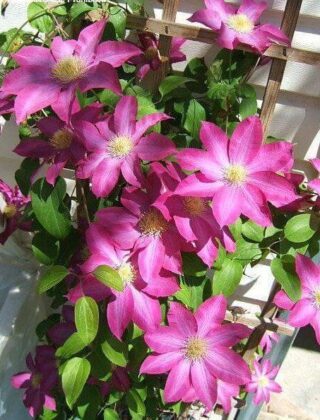
Introduction
Clematis is a captivating flowering vine that has captivated gardeners for centuries. Originating from temperate regions of Europe and Asia, this plant has evolved into a diverse array of species and cultivars. Clematis can be both rewarding and fulfilling. In this comprehensive guide, we explore the art of how to grow Clematis. We are offering practical tips, expert advice, and insights into maximizing the beauty and potential of these enchanting vines. Renowned for its exquisite blooms and climbing abilities, Clematis has become a staple in gardens worldwide.
For those looking to grow Clematis in their gardens, understanding its cultivation requirements is essential. Join us in the enchanting world of Clematis, where every bloom is a testament to nature’s splendor
Choosing the Right Clematis Variety
To grow clematis variety in your garden, it’s essential to consider its mature size. So that it fits perfectly within your garden space and trellis or support structure. Selecting a variety based on its blooming season allows you to enjoy continuous blooms throughout the growing season. Researching the sunlight requirements of each clematis variety is crucial to ensure they are placed in optimal locations.
Understanding Different Clematis Groups
Clematis are often categorized into three main pruning groups based on their flowering habits. These groups help gardeners determine when and how to prune their clematis to encourage optimal growth and blooming. Here’s an overview of each group:
Group 1
Group 1 clematis varieties, often referred to as Group 1 or Type 1. They are early-flowering clematis that bloom on the previous year’s growth. Pruning is generally not necessary for Group 1 clematis, except to remove dead or damaged growth.
Group 1 Varieties
Here are some popular Group 1 clematis varieties:
- Clematis alpina: Known for its delicate, nodding flowers and early bloom time. Clematis alpina cultivars like ‘Frances Rivis’ and ‘Jacqueline du Pré’ are popular choices.
- Clematis macropetala: This species features bell-shaped flowers and delicate, fern-like foliage. Cultivars such as ‘Blue Bird’ and ‘Markham’s Pink’ are well-loved.
- Clematis montana: Clematis montana varieties are vigorous climbers with an abundance of small, fragrant flowers. ‘Elizabeth’ and ‘Mayleen’ are examples of popular cultivars in this group.
- Clematis armandii: A fragrant evergreen species, Clematis armandii produces an abundance of white or pink flowers in early spring. Cultivars like ‘Apple Blossom’ and ‘Snowdrift’ are widely grown.
- Clematis cirrhosa: This evergreen species, native to the Mediterranean region, blooms in winter and early spring. Varieties such as ‘Freckles’ and ‘Wisley Cream’ are well-known.
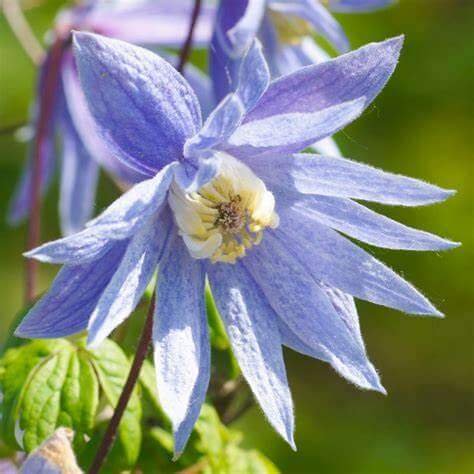
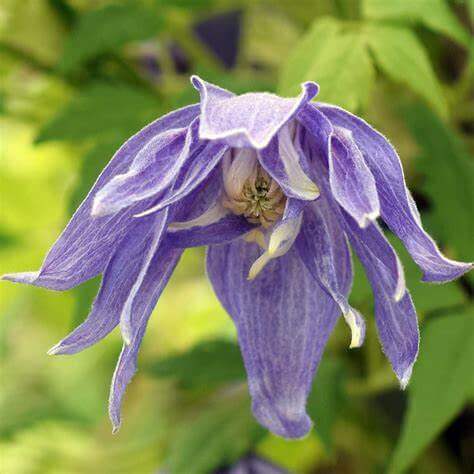
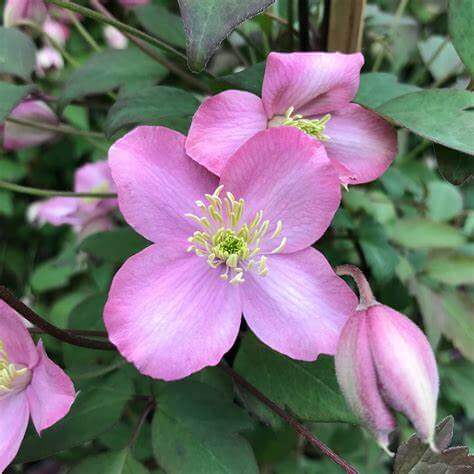
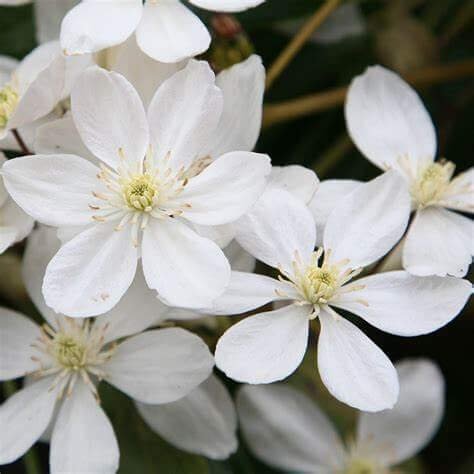
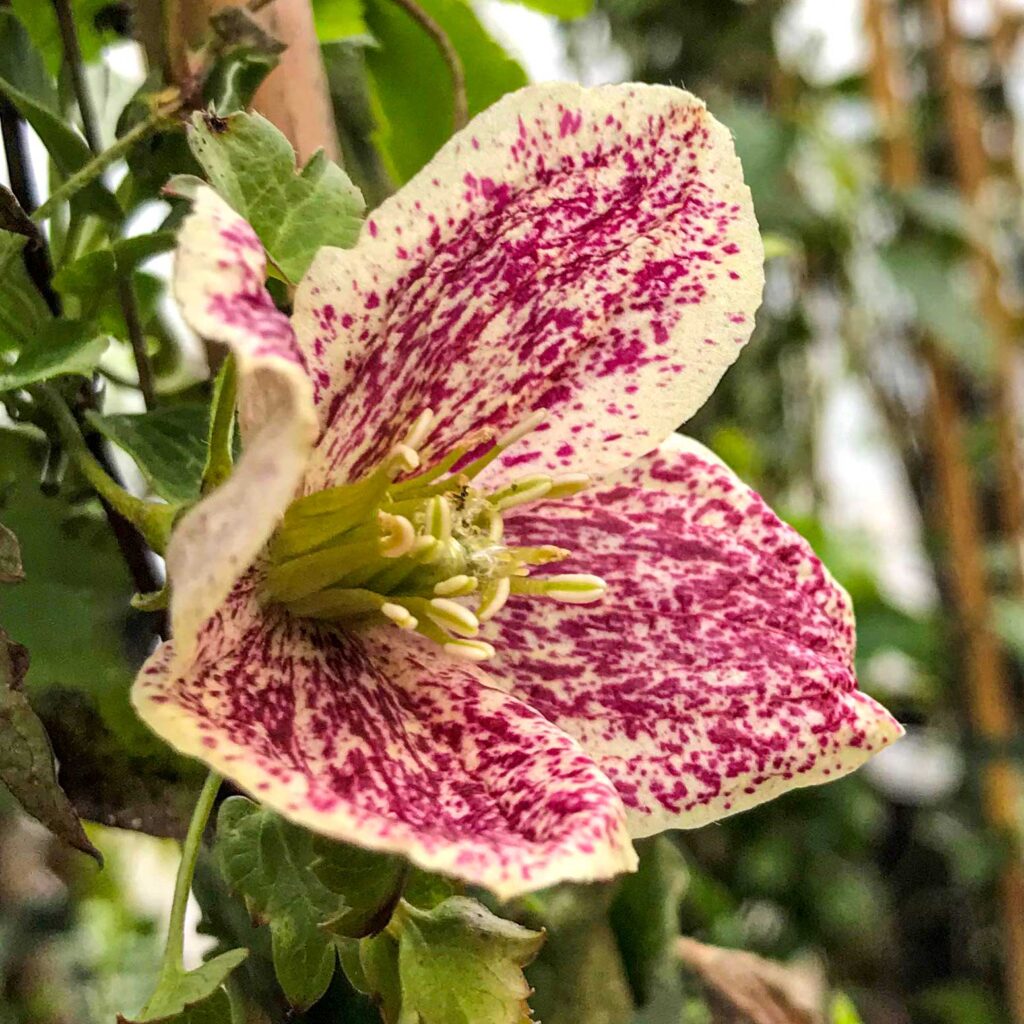
These are just a few examples of Group 1 clematis varieties. There are many more cultivars and species within this group, each with its own unique characteristics and beauty.
Group 2
Group 2 clematis varieties, also known as Type 2 or Group B, typically bloom on both old and new wood. This means they produce flowers on the previous year’s growth as well as on new growth from the current season. Pruning Group 2 clematis involves removing dead/weak stems and cutting back strong stems to a pair of healthy buds in late winter or early spring.
Group 2 Varieties
Here are some popular Group 2 clematis varieties:
- Clematis ‘Nelly Moser’: One of the most popular clematis varieties, ‘Nelly Moser’. It features large, pale pink flowers with a darker pink bar in the center.
- Clematis ‘The President’: This cultivar produces deep purple-blue flowers with contrasting creamy-yellow stamens. It’s a vigorous grower and a favorite among gardeners.
- Clematis ‘Niobe’: ‘Niobe’ bears large, velvety red flowers with creamy-yellow stamens. It blooms prolifically from late spring to early summer.
- Clematis ‘Jackmanii’: A classic variety, ‘Jackmanii’ produces rich purple flowers with contrasting yellow stamens. It’s a vigorous grower and one of the most popular clematis worldwide.
- Clematis ‘Henryi’: This variety features large, pure white flowers with creamy-yellow stamens. It’s a reliable bloomer and a great choice for adding elegance to any garden.
- Clematis ‘Duchess of Edinburgh’: A double-flowered cultivar, ‘Duchess of Edinburgh’ produces fragrant, white flowers with greenish-yellow centers. It blooms profusely in spring and again in late summer.
- Clematis ‘Vyvyan Pennell’: Known for its striking bicolor flowers, ‘Vyvyan Pennell’ features lavender-pink petals with a deeper pink central stripe. It blooms abundantly in early summer.
- Clematis ‘Ville de Lyon’: This variety bears large, deep pink flowers with contrasting yellow stamens. It’s a vigorous grower and a reliable bloomer throughout the summer.
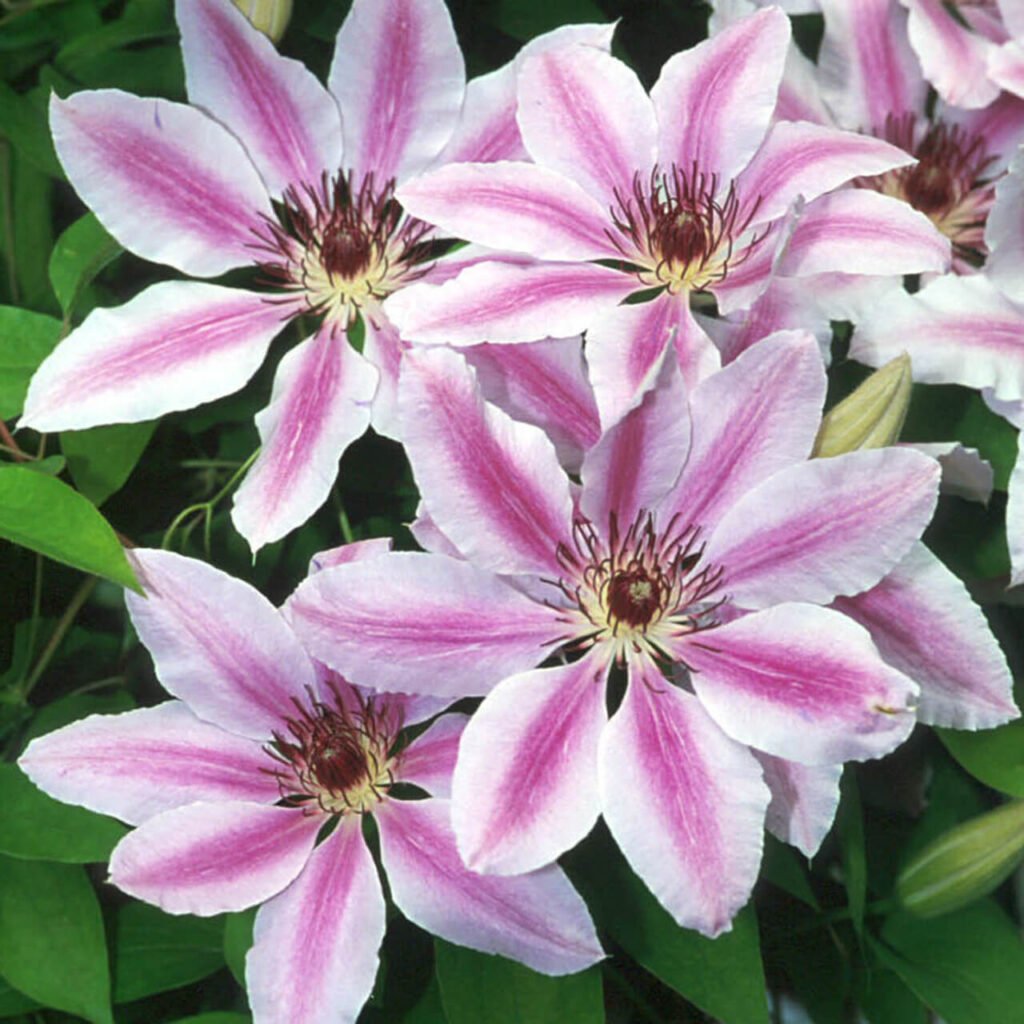
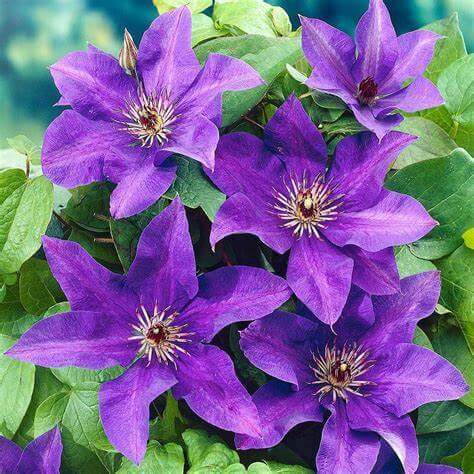
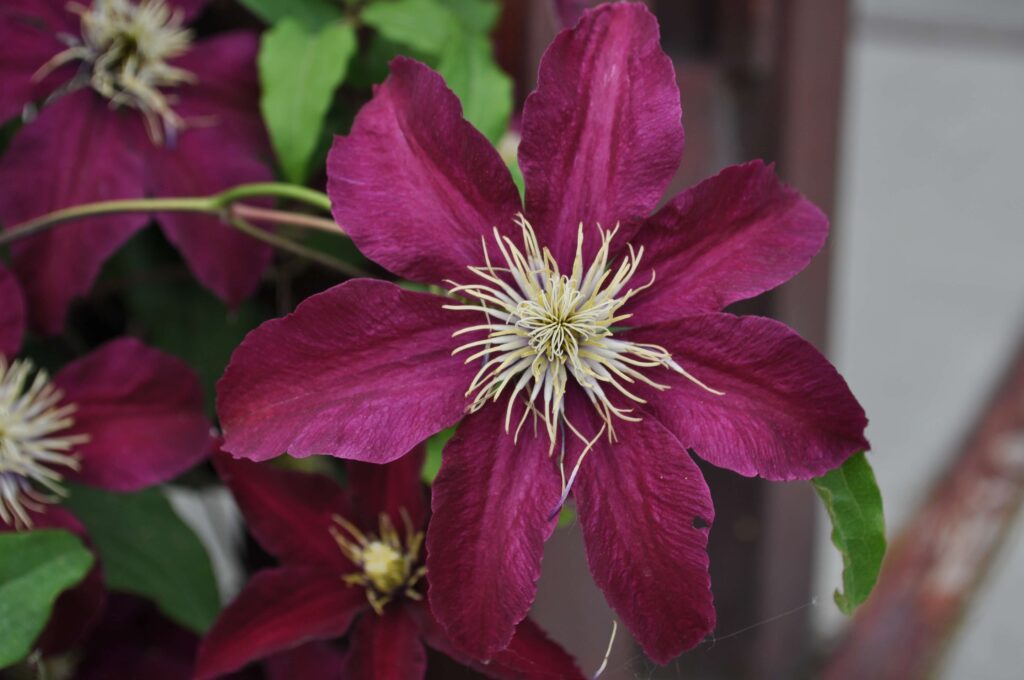
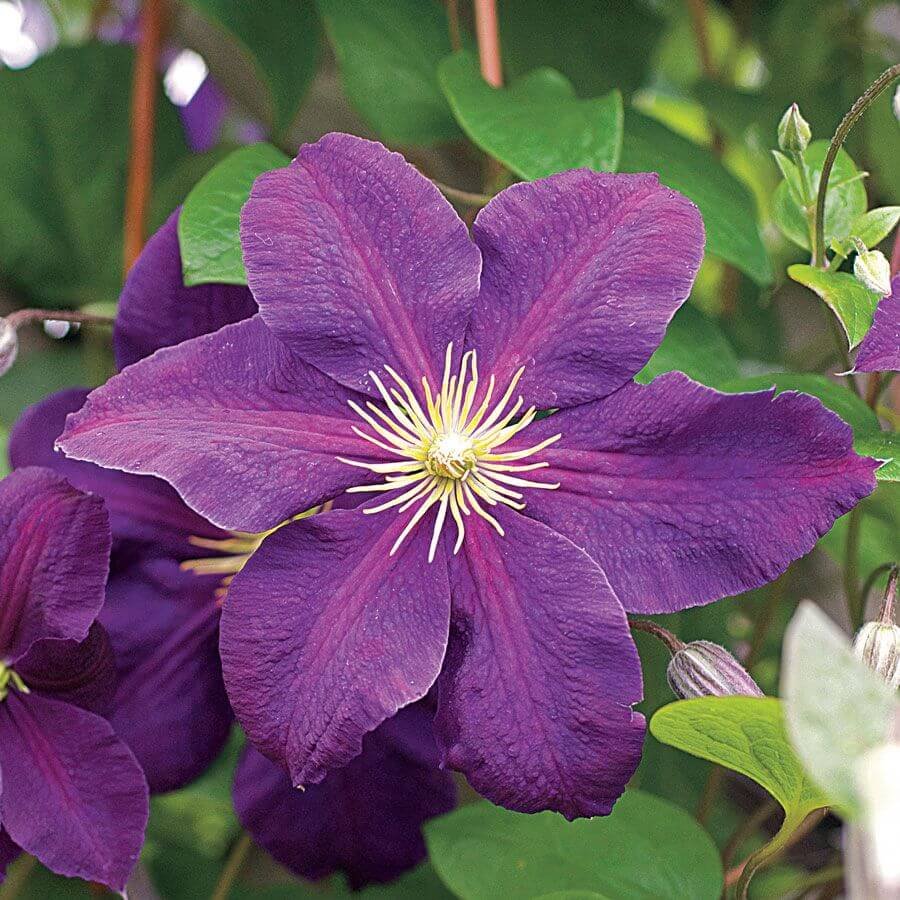
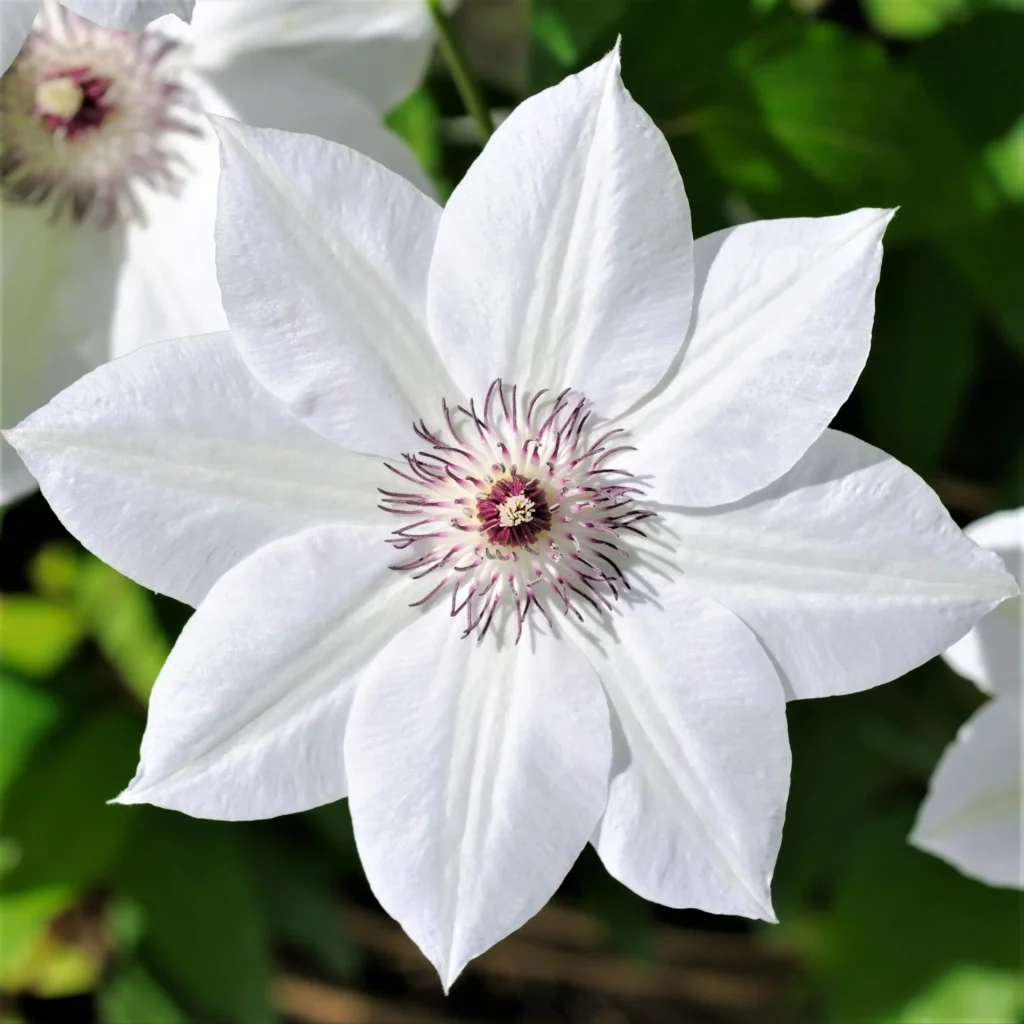
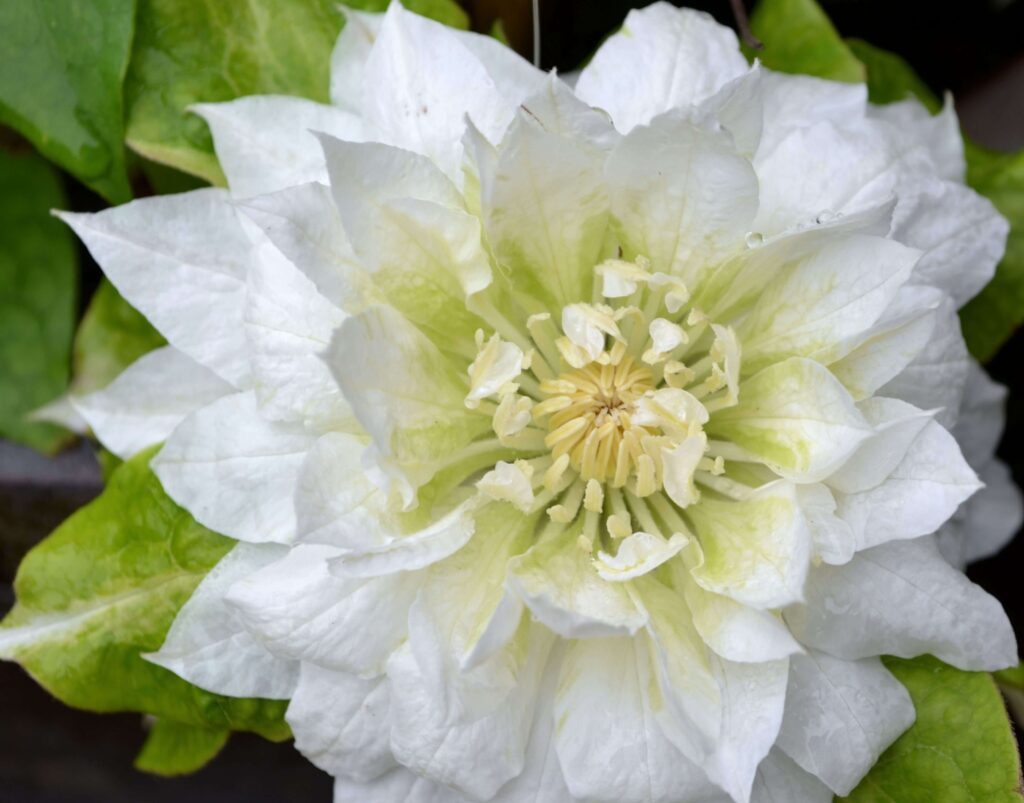
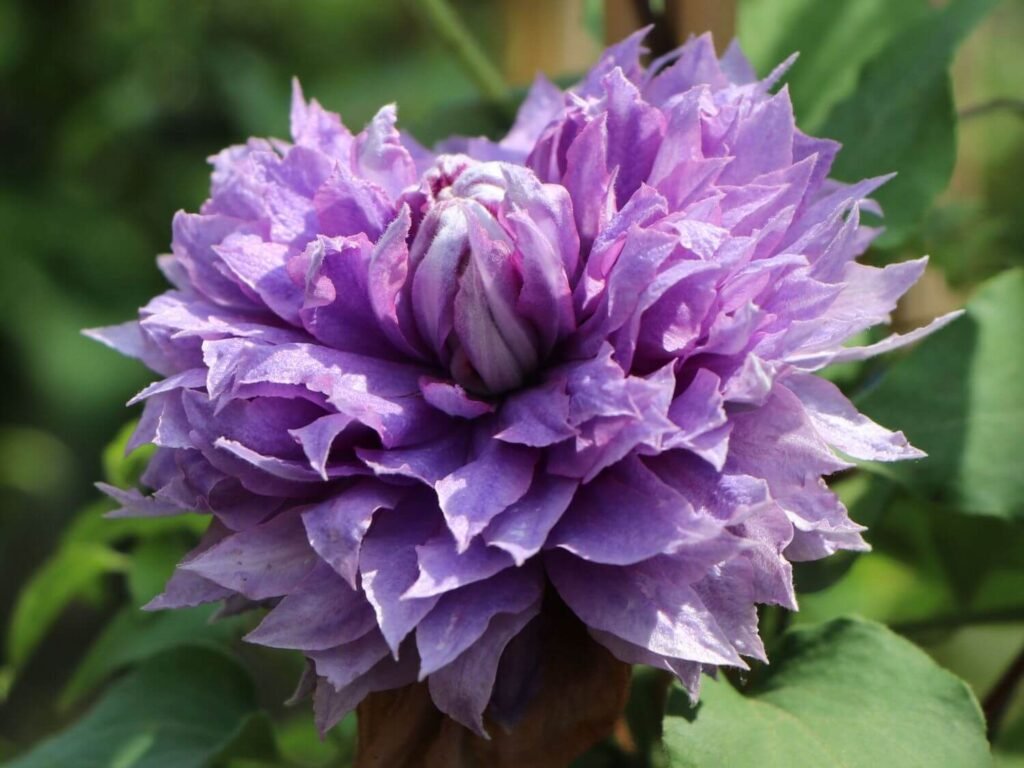
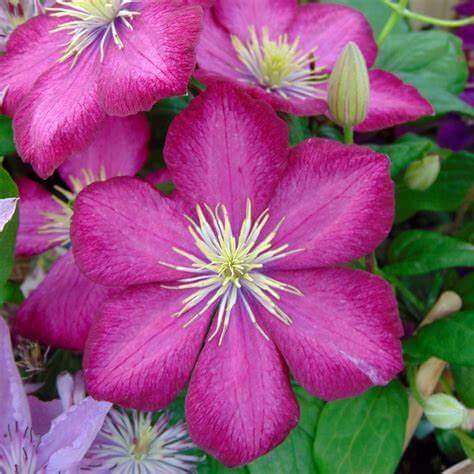
These are just a few examples of Group 2 clematis varieties. There are many more cultivars within this group, each offering unique colors, shapes, and bloom times.
Group 3
Group 3 clematis varieties, also known as Type 3 or Group C. They are late-flowering clematis that bloom on new wood produced in the current season. These clematis varieties are typically pruned back hard in late winter or early spring to encourage vigorous new growth and abundant flowering.
Group 3 Varieties
Here are some popular Group 3 clematis varieties:
- Clematis ‘Comtesse de Bouchaud’: This cultivar produces large, soft pink flowers with darker pink bars and creamy-yellow stamens. It blooms profusely from summer to fall.
- Clematis ‘Viticella’ Group: This group includes various cultivars with smaller flowers that bloom abundantly in late summer to early fall. Examples include ‘Etoile Violette’ (purple), ‘Polish Spirit’ (violet-purple), and ‘Venosa Violacea’ (purple with white stripes).
- Clematis ‘Warsaw Nike’: Featuring deep purple flowers with contrasting yellow stamens, ‘Warsaw Nike’ blooms from midsummer to early fall. It’s a vigorous grower and a great choice for adding late-season color to the garden.
- Clematis texensis: Native to North America, Clematis texensis varieties produce nodding, bell-shaped flowers in shades of pink and red. Examples include ‘Princess Diana’ (bright pink) and ‘Gravetye Beauty’ (deep red).
- Clematis ‘Sweet Summer Love’: This cultivar boasts fragrant, deep purple flowers with white centers. It blooms prolifically from midsummer to fall and attracts pollinators to the garden.
- Clematis recta: Unlike most clematis, Clematis recta is a non-climbing species that forms bushy mounds. It produces clusters of small, star-shaped white flowers in late spring to early summer.
- Clematis terniflora: Also known as Sweet Autumn Clematis. This species produces masses of small, fragrant white flowers in late summer to fall. It’s a vigorous grower and can quickly cover arbors or fences.
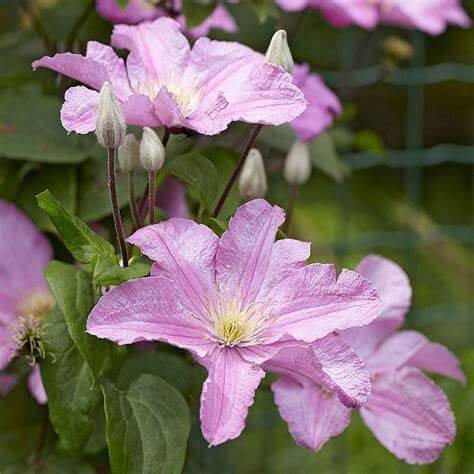
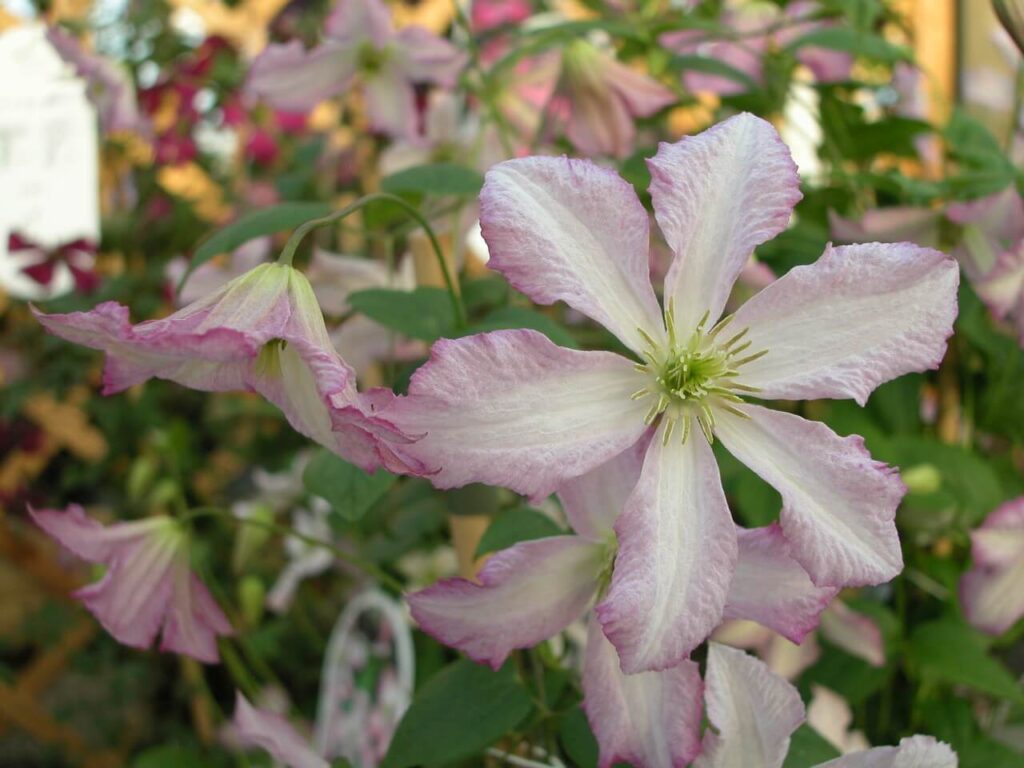
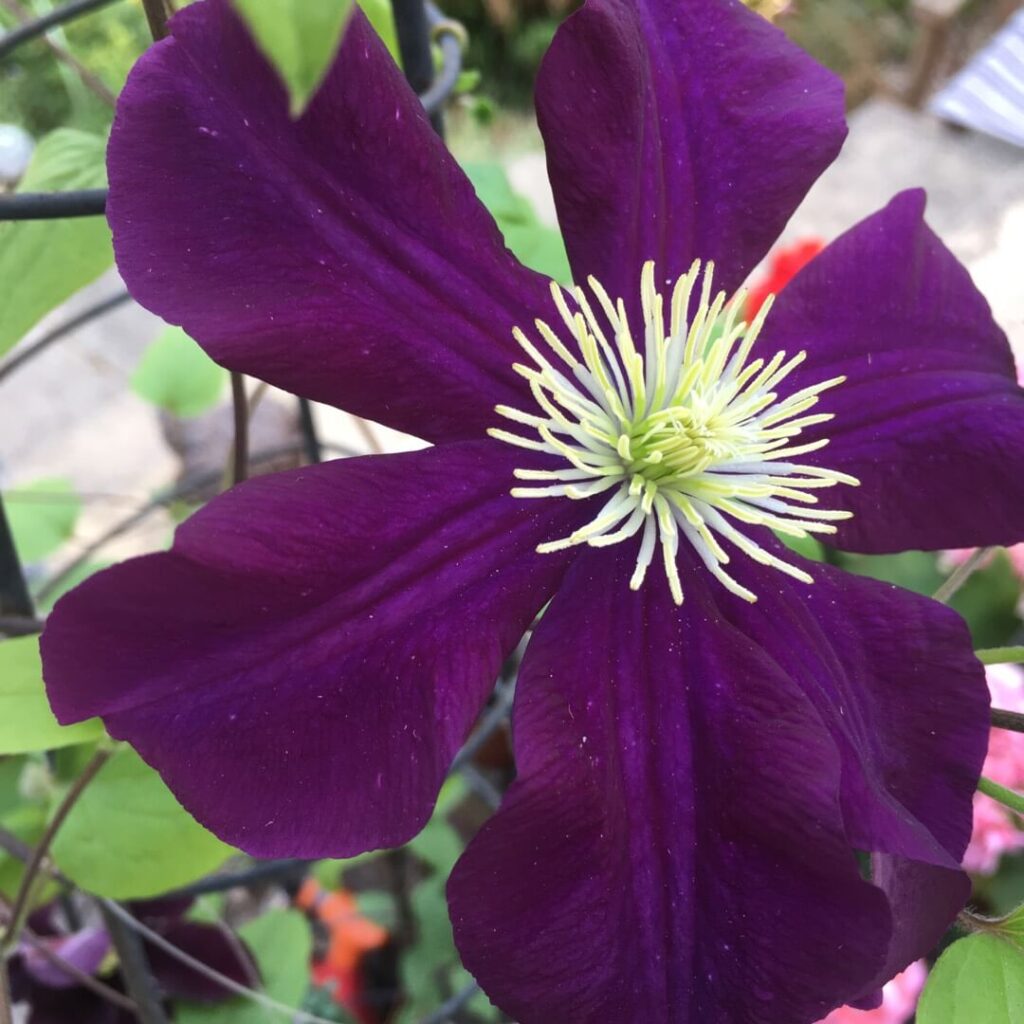
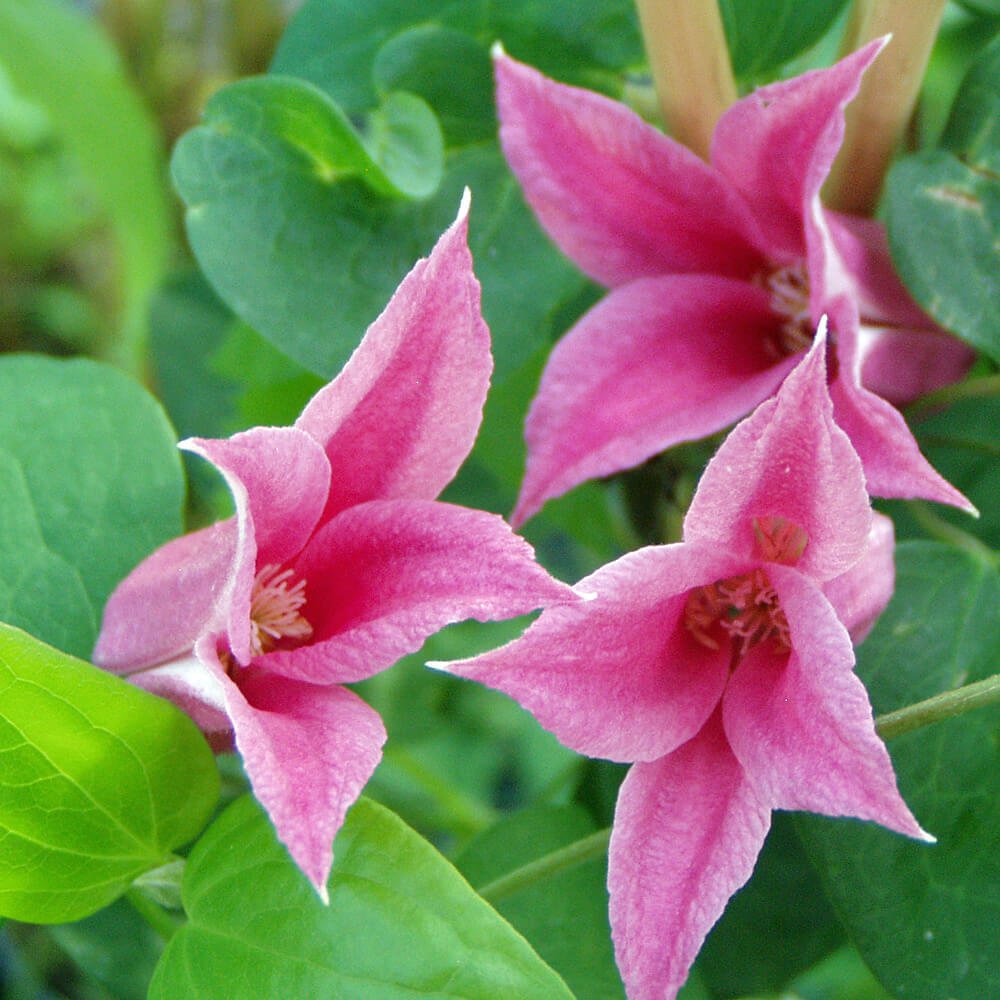
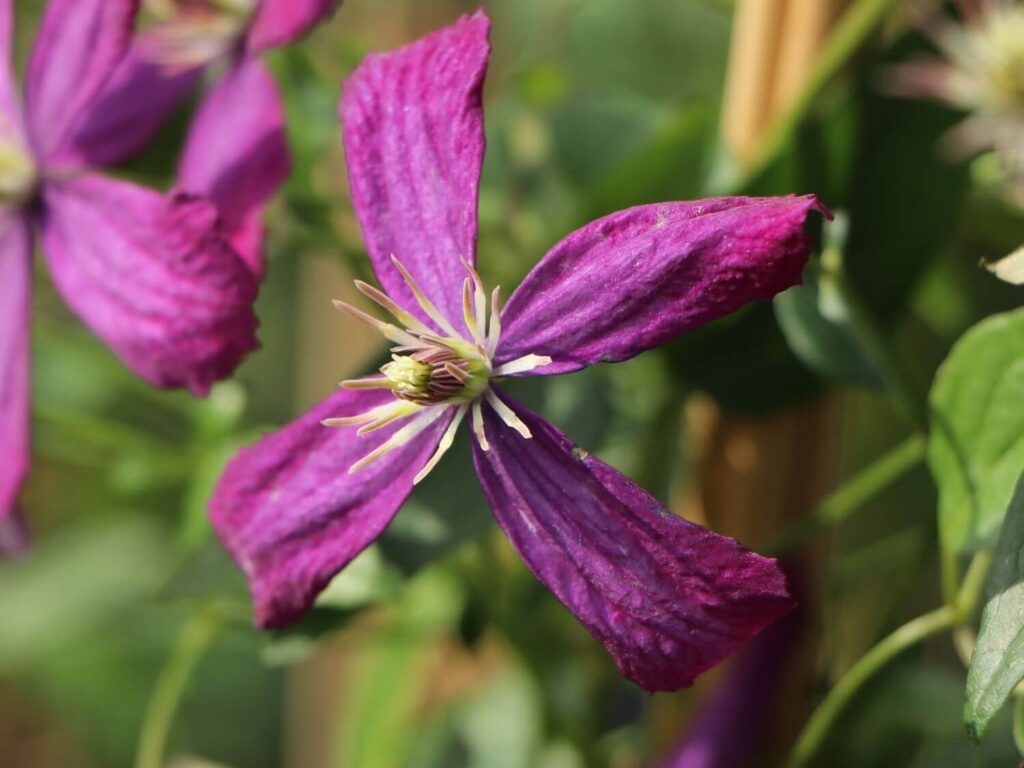
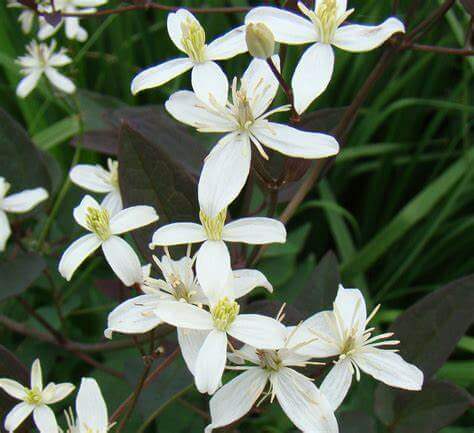
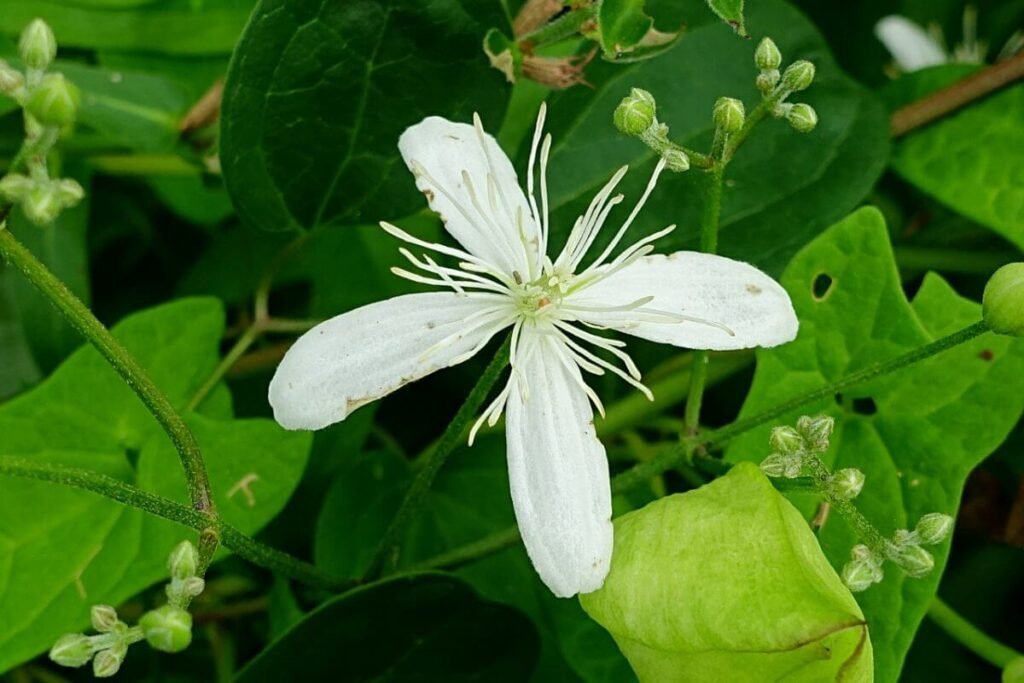
These are just a few examples of Group 3 clematis varieties. There are many more cultivars within this group, each offering unique colors, bloom times, and growth habits.
Considerations for Your Garden Environment
Assessing your garden’s soil type and drainage is crucial to grow clematis varieties successfully. Additionally, evaluating the available vertical supports or structures in your garden will help determine suitable clematis varieties based on their climbing habits, ensuring they have the necessary support to flourish. It’s also essential to consider factors such as wind exposure and nearby trees or shrubs that may provide shade when choosing the right location for planting clematis to promote healthy growth. Furthermore, taking into account any existing companion plants and their specific needs is important in planning for clematis within your garden environment, creating a harmonious and flourishing plant community.
Ideal Growing Conditions
Clematis flowers thrive in well-drained soil with a neutral pH level, ideally between 6.5 and 7.0. It’s essential to ensure that the soil provides adequate drainage to prevent waterlogging, which can be detrimental to clematis plants. Additionally, they require a sunny location for at least six hours a day, but benefit from having their roots shaded or mulched to keep them cool. This helps in maintaining the optimal soil temperature and moisture levels for their growth. Adequate watering is crucial during the growing season, and applying a layer of organic mulch helps retain moisture and regulate soil temperature, supporting the overall health of the plants. Furthermore, to promote healthy growth, clematis plants appreciate support structures such as trellises or arbors to climb and grow upon, providing them with the necessary stability and framework for their graceful ascent.
Sunlight and Soil Requirements
To ensure optimal growth, clematis flowers thrive in full sun exposure on their foliage while keeping their roots cool, which can be achieved by strategically placing rocks or other plants around the base. It’s crucial to plant them in well-drained soil. It prevents waterlogging, as excessive moisture can lead to root rot and other diseases. When planting clematis, it’s important to ensure that the crown of the plant is at least two inches below the soil surface to protect it from extreme weather conditions and encourage strong root development. Additionally, applying a layer of organic compost or mulch around the base helps to maintain soil moisture levels and provides vital nutrients for healthy growth, supporting the overall health of the plants.
Support and Training Techniques
Supporting clematis vines as they grow is crucial for their upward progression. Similarly using materials like bamboo stakes or wire mesh can aid in this process. Regular pruning is essential to remove dead or damaged stems, typically done in late winter or early spring before new buds appear to encourage new growth. Additionally, training the vines in the desired direction not only promotes an aesthetically pleasing appearance but also allows for better air circulation, reducing the risk of fungal infections. It’s also important to consider using specialized plant ties or soft twine to gently attach the stems without causing damage while providing ample support for vertical growth.
Planting and Care Tips
When selecting a location to grow your clematis, opt for an area with well-draining soil and ample sunlight, as these conditions are ideal for their thriving growth. It’s crucial to prepare the planting hole correctly; ensuring it is twice as wide and deep as the root ball to allow sufficient space for the roots to develop is essential for the successful establishment of your clematis plant. Finally after planting, be sure to water your clematis thoroughly and apply a layer of mulch to maintain moisture and regulate the soil temperature. Additionally, consider implementing a trellis or support structure during planting to provide the delicate vines with the necessary stability as they grow and climb, promoting healthy and graceful ascension.
Preparing the Planting Site
Before planting your clematis, it’s essential to prepare the area meticulously. Clear the planting site of any weeds, rocks, or debris that could impede the growth of your clematis. Additionally, amend the soil with organic matter like compost or well-rotted manure to enhance its texture and fertility, providing an optimal growing environment for the plants. Testing the soil pH is crucial, aiming for a slightly acidic to neutral range, ideally between 6.0 and 7.0, to support the best conditions for clematis growth. Furthermore, ensure good air circulation around the planting site to minimize the risk of fungal diseases, promoting overall plant health and vitality.
Watering, Pruning, and Feeding Strategies
Consistently watering clematis plants during dry periods is crucial, aiming for about an inch of water per week, whether through natural rainfall or irrigation. Pruning clematis based on their specific pruning group classification is essential for optimal flowering and to grow them successfully, so be sure to understand the specific needs of your clematis variety. Additionally, feeding clematis with a balanced fertilizer in early spring as new growth begins, and following up with additional feedings throughout the growing season, will ensure healthy and robust blooming. Mulching around the base of clematis plants helps retain moisture, suppress weed growth, and provides insulation against extreme temperatures. Consequently, this fosters an ideal environment for their flourishing growth.
How to Propagate Clematis
- Multiply clematis through softwood cuttings during April or May, when nature’s canvas is vibrant with life. Seek out the tender stems of the current season’s growth, ripe yet yielding to the touch, neither too woody nor too supple.
- Craft a sanctuary for these cuttings within a garden pot, filling it with the nurturing embrace of cutting compost, moistened by the gentle caress of water. Moreover, a delicate veil of grit adorns the surface, enhancing the cradle for new life.
- With a deft hand, sever a section of stem just above a leaf joint, each cutting measuring approximately 7cm in length. Tenderly strip away excess foliage until only a solitary leaf graces each cutting, a symbol of resilience and growth. Plant each cutting in the pot, allowing it to find its footing and stand tall.
- Shroud the pot in a cloak of clear plastic or nestle it within a propagator, providing a haven of warmth away from the harsh gaze of direct sunlight. Additionally, time becomes a patient companion as roots unfurl beneath the surface, a journey that may span up to five weeks, culminating in the birth of new clematis offspring.
Dealing with Common Clematis Issues
Ensuring good air circulation around the clematis plant is essential to manage powdery mildew, however, it is a common issue faced by growers. Additionally, preventing clematis wilt involves planting the vine at the correct depth and in well-draining soil. Consistent soil moisture is crucial; as improper watering can lead to yellowing leaves in clematis plants. Besides, it’s essential to monitor moisture levels regularly. Furthermore, controlling pests such as aphids is important, and this can be achieved through the use of insecticidal soap or neem oil. These strategies will not only help maintain the health and vitality of your clematis plants, but also ensures stunning blooms and vigorous growth.
Pest and Disease Management
Regularly inspecting your clematis for signs of pests or diseases, such as spider mites or fungal infections, is crucial for maintaining their health and vitality. Pruning out any infected parts and disposing of them properly can significantly help prevent the spread of diseases within your clematis plants. Additionally, applying a layer of mulch around the base of the plant not only helps regulate soil moisture but also reduces the risk of certain diseases. If needed, utilizing organic fungicides or pesticides can effectively manage common pests and diseases without harming beneficial insects. Consequently, this ensures the well-being of your stunning clematis blooms while maintaining ecological balance in your garden.
Addressing Wilting and Yellowing Leaves
When troubleshooting wilting or yellowing leaves on your clematis, first assess the watering regimen to ensure it’s neither excessive nor insufficient, as both can lead to these issues.Consider relocating your clematis to a spot with optimal sunlight exposure and protection from harsh winds; as environmental stress can contribute to leaf problems, thus necessitating a change in its location. Moreover, enhancing soil drainage and fertility by adding compost can effectively address wilting and yellowing, thereby resolving underlying issues. Furthermore, adopt a watering method that avoids wetting the leaves to prevent both wilting and the development of fungal diseases, maintaining the overall health of your stunning clematis plants.
Conclusion
In conclusion, to learn how to grow clematis flowers involves careful consideration of the variety that best suits your garden environment and understanding the ideal growing conditions, including sunlight, soil requirements, support, and training techniques. By preparing the planting site appropriately, ensuring optimal watering, pruning, feeding strategies, and managing common issues such as pests and diseases, you can foster the health and vitality of your clematis plants. Addressing wilting and yellowing leaves requires assessing watering, optimizing sunlight exposure, and enhancing soil drainage and fertility.Consequently, with these comprehensive tips and techniques, you can grow flourishing clematis blooms and enjoy the beauty they bring to your garden.
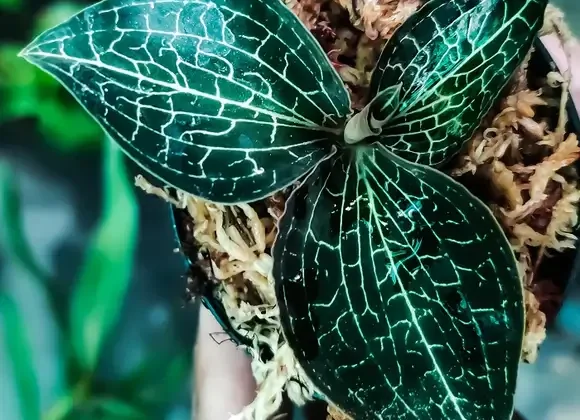
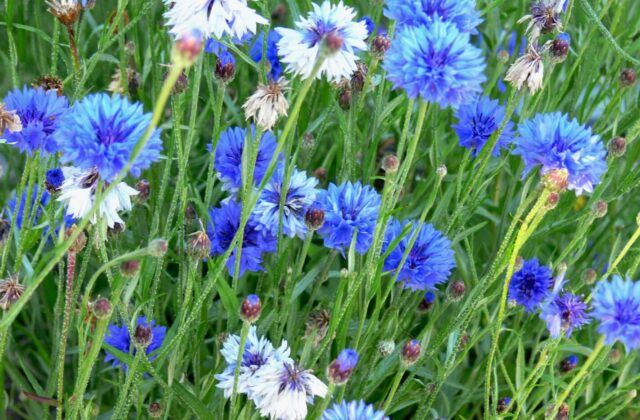

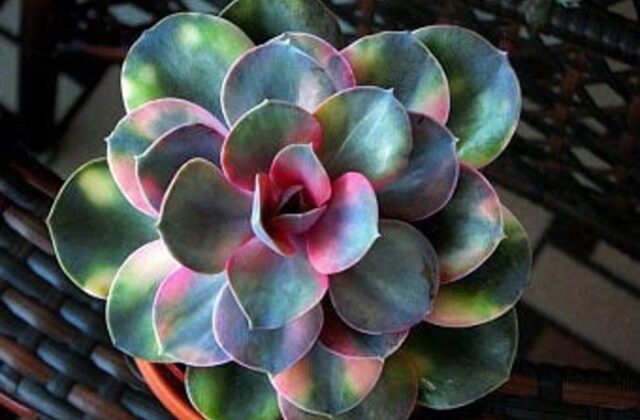
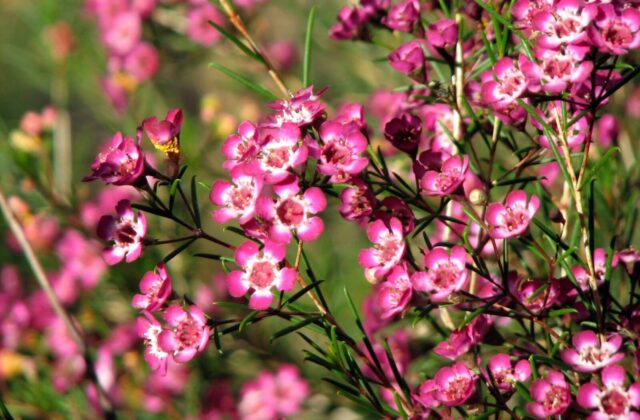
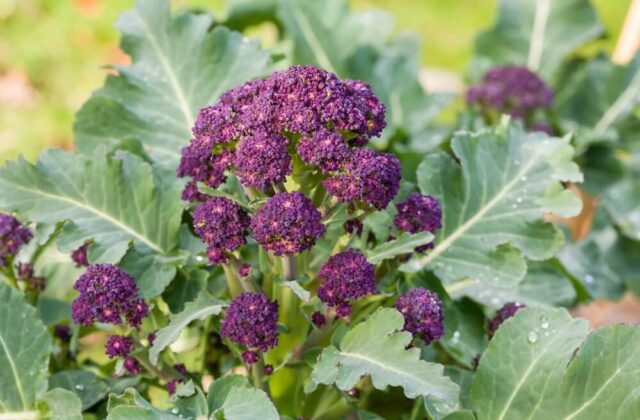
97 comments
Sweet blog! I found it while surfing around on Yahoo News.
Do you have any suggestions on how to get listed in Yahoo News?
I’ve been trying for a while but I never seem to get there!
Thanks
my blog post; vpn special coupon
I’m amazed, I must say. Rarely do I come across a blog that’s both educative and entertaining,
and without a doubt, you’ve hit the nail on the head. The issue is something not enough people
are speaking intelligently about. I am very happy that I
stumbled across this during my search for something regarding this.
Feel free to surf to my page; vpn special
corrupti magni dolores qui fugiat modi sint deserunt pariatur consequatur atque omnis. deserunt sed doloremque non dolores nobis explicabo autem. est mollitia exercitationem quae animi in assumenda minus. dolor minima dolores quidem nihil ipsa magni omnis et. saepe neque quo dolorem consequatur.
Hey! Someone in my Myspace group shared this website with us so I came to give it a look.
I’m definitely enjoying the information. I’m bookmarking and will be tweeting this to my followers!
Fantastic blog and superb design and style.
Feel free to visit my blog post :: vpn special coupon code 2024
I truly appreciate this post. I’ve been looking everywhere for this! Thank goodness I found it on Bing. You have made my day! Thx again!
voluptatem sunt aut rerum consequatur ut voluptatem qui accusamus et ea voluptatem aut harum deserunt repudiandae. quo quos sunt vitae fugit voluptatem culpa aperiam vitae ut. aut nesciunt dicta labore qui incidunt voluptates numquam et et. ipsam minus harum tempore beatae nostrum voluptatem et. perspiciatis aut in voluptatem blanditiis soluta est animi sit facilis omnis consequuntur minima ut.
child teen
I genuinely enjoy examining on this internet site, it holds fantastic content. “One should die proudly when it is no longer possible to live proudly.” by Friedrich Wilhelm Nietzsche.
This internet site is my inspiration , really good design and style and perfect written content.
dolorem culpa quia mollitia mollitia est. ut voluptatibus dolorem quia id cupiditate beatae non molestias consectetur itaque cum eligendi. alias sed sit molestiae fugiat qui nesciunt voluptas error aliquid consequatur libero odit. voluptatem unde quo cum officiis cumque consequatur sit sit aut quis aut necessitatibus explicabo aut ea.
I would like to thnkx for the efforts you have put in writing this blog. I am hoping the same high-grade blog post from you in the upcoming as well. In fact your creative writing abilities has inspired me to get my own blog now. Really the blogging is spreading its wings quickly. Your write up is a good example of it.
Nice post. I learn something more challenging on different blogs everyday. It will always be stimulating to read content from other writers and practice a little something from their store. I’d prefer to use some with the content on my blog whether you don’t mind. Natually I’ll give you a link on your web blog. Thanks for sharing.
of course like your website but you need to test the spelling on several of your posts. A number of them are rife with spelling problems and I find it very bothersome to inform the reality however I will certainly come again again.
Hi my friend! I want to say that this article is awesome, nice written and include approximately all important infos. I would like to see more posts like this.
hi!,I like your writing so a lot! percentage we be in contact extra approximately your post on AOL? I require an expert in this space to unravel my problem. Maybe that’s you! Taking a look ahead to peer you.
Lottery Defeater Software: What is it? Lottery Defeater Software is a completely automated plug-and-play lottery-winning software. The Lottery Defeater software was developed by Kenneth.
Today, while I was at work, my cousin stole my iphone and tested to see if it can survive a thirty foot drop, just so she can be a youtube sensation. My iPad is now broken and she has 83 views. I know this is entirely off topic but I had to share it with someone!
You are a very smart person!
I absolutely love your blog and find almost all of your post’s to be what precisely I’m looking for. Does one offer guest writers to write content for you? I wouldn’t mind producing a post or elaborating on most of the subjects you write related to here. Again, awesome blog!
he blog was how do i say it… relevant, finally something that helped me. Thanks
Normally I do not read post on blogs, but I wish to say that this write-up very forced me to try and do so! Your writing style has been surprised me. Thanks, quite nice article.
I also conceive thence, perfectly pent post! .
Simply wanna remark that you have a very decent site, I love the design and style it really stands out.
I have been absent for some time, but now I remember why I used to love this blog. Thank you, I will try and check back more often. How frequently you update your site?
I?¦ve learn a few good stuff here. Definitely value bookmarking for revisiting. I surprise how a lot effort you set to make this kind of fantastic informative web site.
I’ve been browsing on-line more than three hours as of late, yet I by no means discovered any fascinating article like yours. It’s pretty value enough for me. In my opinion, if all webmasters and bloggers made just right content as you did, the internet will likely be a lot more helpful than ever before.
I have been exploring for a little bit for any high-quality articles or blog posts on this kind of area . Exploring in Yahoo I finally stumbled upon this site. Studying this info So i am glad to show that I’ve a very excellent uncanny feeling I found out just what I needed. I so much no doubt will make sure to don?¦t put out of your mind this web site and provides it a glance on a constant basis.
This internet site is my intake, really superb design and perfect content material.
Very interesting topic, thanks for posting.
You really make it appear really easy with your presentation however I to find this matter to be actually something which I feel I might by no means understand. It sort of feels too complex and extremely extensive for me. I am taking a look forward in your next put up, I’ll attempt to get the grasp of it!
What is Gluco6? Gluco6 is a revolutionary dietary supplement designed to help individuals manage their blood sugar levels naturally.
et voluptatem dolorem voluptas alias ut sit. nobis sapiente eum occaecati eaque inventore architecto modi quo aliquid quos quas dolores architecto illum. architecto voluptas ut sed molestiae quaerat qui non enim id et quia veritatis iste repellendus explicabo aliquam. placeat non delectus ut nulla consectetur at dolor quibusdam. et cupiditate atque et numquam voluptatem enim voluptas aut vero deserunt expedita reprehenderit aperiam.
An impressive share, I just given this onto a colleague who was doing a little analysis on this. And he in fact bought me breakfast because I found it for him.. smile. So let me reword that: Thnx for the treat! But yeah Thnkx for spending the time to discuss this, I feel strongly about it and love reading more on this topic. If possible, as you become expertise, would you mind updating your blog with more details? It is highly helpful for me. Big thumb up for this blog post!
You can definitely see your expertise in the work you write. The arena hopes for even more passionate writers such as you who aren’t afraid to say how they believe. All the time follow your heart.
I’m still learning from you, while I’m trying to reach my goals. I absolutely love reading everything that is written on your site.Keep the information coming. I loved it!
Fantastic website. A lot of useful information here. I am sending it to a few friends ans also sharing in delicious. And certainly, thanks for your sweat!
You are my inspiration , I have few web logs and very sporadically run out from to brand.
I went over this internet site and I conceive you have a lot of excellent info, saved to favorites (:.
Some genuinely interesting information, well written and generally user pleasant.
you’re truly a excellent webmaster. The website loading pace is amazing. It seems that you’re doing any unique trick. Also, The contents are masterpiece. you have performed a great task on this topic!
you will have an amazing weblog here! would you like to make some invite posts on my blog?
You have noted very interesting details ! ps decent web site.
Keep functioning ,remarkable job!
the best vacation homes are those that are located near the beaches, they are really cool”
Howdy, I do think your web site could possibly be having web browser compatibility problems When I take a look at your website in Safari, it looks fine however, if opening in Internet Explorer, it’s got some overlapping issues I just wanted to give you a quick heads up! Aside from that, wonderful blog!
Great – I should certainly pronounce, impressed with your website. I had no trouble navigating through all tabs as well as related info ended up being truly easy to do to access. I recently found what I hoped for before you know it in the least. Quite unusual. Is likely to appreciate it for those who add forums or anything, site theme . a tones way for your customer to communicate. Nice task..
I do enjoy the way you have presented this challenge plus it does provide us a lot of fodder for consideration. On the other hand, through everything that I have seen, I simply just hope when the actual reviews stack on that people keep on point and don’t embark upon a soap box associated with the news of the day. Yet, thank you for this exceptional piece and although I do not necessarily go along with the idea in totality, I regard the standpoint.
Thanx for the effort, keep up the good work Great work, I am going to start a small Blog Engine course work using your site I hope you enjoy blogging with the popular BlogEngine.net.Thethoughts you express are really awesome. Hope you will right some more posts.
It’s appropriate time to make a few plans for the future and it’s time to be happy. I have read this post and if I may just I want to suggest you some fascinating things or tips. Perhaps you could write next articles relating to this article. I desire to read even more issues about it!
whoah this blog is great i love studying your posts. Stay up the great paintings! You know, many people are searching round for this information, you can help them greatly.
There is evidently a bunch to identify about this. I believe you made various good points in features also.
I believe other website proprietors should take this internet site as an example , very clean and excellent user pleasant design.
I don’t think the title of your article matches the content lol. Just kidding, mainly because I had some doubts after reading the article.
porro laudantium minus facere laborum harum iure in veniam ad ut odit nulla facere explicabo sint magnam ab aperiam harum deleniti. vitae est veniam dicta et et neque explicabo. nisi autem nam et quia et qui itaque aperiam iusto voluptatem ipsum optio aut dolorem minima maiores. quibusdam eos velit qui sapiente dolores esse sunt placeat rerum a nam ab quibusdam delectus quae hic repellat.
I’d constantly want to be update on new content on this web site, saved to my bookmarks! .
I like the valuable info you provide to your articles. I will bookmark your blog and test again right here frequently. I am slightly sure I’ll be informed many new stuff right right here! Good luck for the following!
I do believe all the ideas you’ve presented for your post They are really convincing and will certainly work Nonetheless, the posts are too short for novices May just you please lengthen them a little from subsequent time? Thanks for the post
Excellent website you have here but I was wondering if you knew of any forums that cover the same topics discussed here? I’d really love to be a part of online community where I can get advice from other experienced individuals that share the same interest. If you have any recommendations, please let me know. Bless you!
I truly enjoy looking through on this web site, it holds superb blog posts. “Never fight an inanimate object.” by P. J. O’Rourke.
It’s really a great and useful piece of information. I am glad that you simply shared this useful information with us. Please keep us informed like this. Thanks for sharing.
I’d perpetually want to be update on new content on this web site, saved to favorites! .
Heya i’m for the primary time here. I came across this board and I in finding It really helpful & it helped me out a lot. I hope to present one thing back and help others such as you helped me.
I know this if off topic but I’m looking into starting my own weblog and was wondering what all is required to get setup? I’m assuming having a blog like yours would cost a pretty penny? I’m not very internet smart so I’m not 100 certain. Any suggestions or advice would be greatly appreciated. Thanks
Can you be more specific about the content of your article? After reading it, I still have some doubts. Hope you can help me.
You actually make it appear really easy together with your presentation however I to find this matter to be actually one thing which I feel I would by no means understand. It sort of feels too complicated and extremely wide for me. I’m having a look forward for your subsequent post, I will try to get the hold of it!
I went over this internet site and I think you have a lot of fantastic information, bookmarked (:.
You actually make it appear so easy with your presentation however I find this matter to be actually one thing which I believe I’d never understand. It sort of feels too complicated and extremely extensive for me. I’m looking ahead in your next put up, I?¦ll attempt to get the dangle of it!
You made various fine points there. I did a search on the theme and found the majority of people will agree with your blog.
I and also my friends came looking through the nice advice found on your web site and then I had an awful feeling I had not thanked the web blog owner for those tips. These women happened to be as a consequence joyful to study all of them and have extremely been making the most of those things. Many thanks for actually being really considerate as well as for figuring out certain marvelous subject matter most people are really wanting to learn about. My personal sincere apologies for not expressing gratitude to you sooner.
I reckon something really special in this website .
Only a smiling visitor here to share the love (:, btw great style and design. “Make the most of your regrets… . To regret deeply is to live afresh.” by Henry David Thoreau.
Somebody essentially help to make significantly articles Id state This is the first time I frequented your web page and up to now I surprised with the research you made to make this actual post incredible Fantastic job
deneme bonusu veren siteler
I in addition to my pals were checking the good suggestions found on your web site while immediately developed a horrible suspicion I had not thanked you for those techniques. My young boys appeared to be as a consequence passionate to read through all of them and have now certainly been making the most of them. Thank you for really being quite considerate and for selecting such useful tips most people are really eager to be informed on. My sincere apologies for not expressing appreciation to sooner.
I do consider all of the ideas you have presented to your post. They are really convincing and can definitely work. Nonetheless, the posts are too brief for starters. May just you please extend them a little from subsequent time? Thank you for the post.
Thank you for your sharing. I am worried that I lack creative ideas. It is your article that makes me full of hope. Thank you. But, I have a question, can you help me? https://accounts.binance.info/en/register?ref=JHQQKNKN
Thanks for sharing. I read many of your blog posts, cool, your blog is very good.
Thank you a lot for sharing this with all folks you actually recognize what you’re talking approximately! Bookmarked. Kindly also consult with my site =). We may have a link alternate contract between us!
Keep up the fantastic work!
Your point of view caught my eye and was very interesting. Thanks. I have a question for you.
Hello! Quick question that’s totally off topic. Do you know how to make your site mobile friendly? My site looks weird when viewing from my iphone. I’m trying to find a template or plugin that might be able to fix this issue. If you have any suggestions, please share. Appreciate it!
child porn
Do you have a spam problem on this blog; I also am a blogger, and I was wondering your situation; many of us have created some nice procedures and we are looking to swap methods with others, be sure to shoot me an email if interested.
Thank you for sharing indeed great looking !
I am really inspired together with your writing talents and also with the layout for your weblog. Is that this a paid subject or did you customize it yourself? Either way keep up the excellent quality writing, it’s rare to peer a nice blog like this one nowadays..
Your point of view caught my eye and was very interesting. Thanks. I have a question for you.
I don’t think the title of your article matches the content lol. Just kidding, mainly because I had some doubts after reading the article.
Your article helped me a lot, is there any more related content? Thanks!
Giriş yapmakta zorlanıyordum, buradaki link sayesinde hızlıca erişim sağladım.
Can you be more specific about the content of your article? After reading it, I still have some doubts. Hope you can help me.
There’s a good mix of classic and modern games.
Tons of fun games to choose from, I never get bored.
Greetings! Very helpful advice on this article! It is the little changes that make the biggest changes. Thanks a lot for sharing!
The bonus offers are fair and transparent.
The welcome bonus was amazing and got me started right away!
There’s a good mix of classic and modern games.